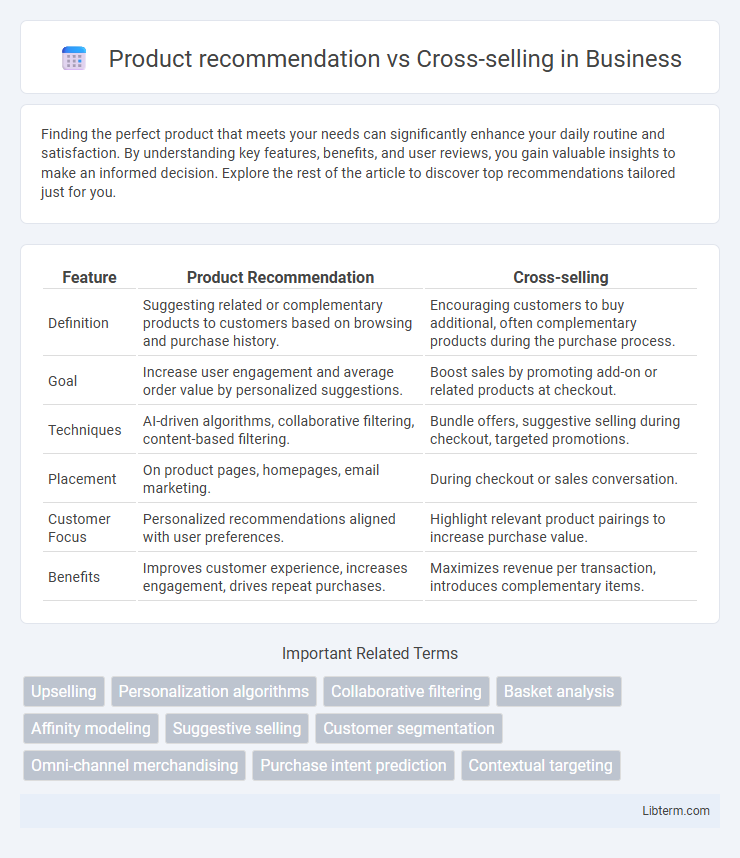Finding the perfect product that meets your needs can significantly enhance your daily routine and satisfaction. By understanding key features, benefits, and user reviews, you gain valuable insights to make an informed decision. Explore the rest of the article to discover top recommendations tailored just for you.
Table of Comparison
| Feature | Product Recommendation | Cross-selling |
|---|---|---|
| Definition | Suggesting related or complementary products to customers based on browsing and purchase history. | Encouraging customers to buy additional, often complementary products during the purchase process. |
| Goal | Increase user engagement and average order value by personalized suggestions. | Boost sales by promoting add-on or related products at checkout. |
| Techniques | AI-driven algorithms, collaborative filtering, content-based filtering. | Bundle offers, suggestive selling during checkout, targeted promotions. |
| Placement | On product pages, homepages, email marketing. | During checkout or sales conversation. |
| Customer Focus | Personalized recommendations aligned with user preferences. | Highlight relevant product pairings to increase purchase value. |
| Benefits | Improves customer experience, increases engagement, drives repeat purchases. | Maximizes revenue per transaction, introduces complementary items. |
Understanding Product Recommendation
Product recommendation systems analyze user behavior and preferences to suggest relevant items, enhancing customer experience and increasing sales conversion rates. By leveraging machine learning algorithms and data analytics, these systems predict products that individual users are likely to purchase, driving personalized marketing strategies. Understanding product recommendation enables businesses to tailor their offerings, optimize inventory management, and improve overall customer engagement.
Defining Cross-Selling Strategies
Cross-selling strategies involve identifying complementary products that enhance the customer's original purchase, increasing overall transaction value and improving customer satisfaction. Effective techniques include personalized product bundles, targeted offers based on purchase history, and leveraging customer data analytics to suggest relevant accessories or upgrades. Implementing cross-selling requires alignment between marketing, sales, and inventory management to optimize product placement and timing during the buying process.
Key Differences: Product Recommendation vs Cross-Selling
Product recommendation involves suggesting items based on a customer's browsing or purchase history to enhance personalization and user experience, while cross-selling targets complementary products to increase the overall transaction value. Product recommendations use algorithms and customer data analysis to tailor suggestions, whereas cross-selling relies on strategic pairing of related products to encourage additional purchases. Both strategies optimize sales, but product recommendations focus on relevance and customer preference, whereas cross-selling emphasizes expanding the sale through related items.
Benefits of Effective Product Recommendations
Effective product recommendations enhance customer experience by delivering personalized suggestions based on browsing history and purchase behavior, increasing engagement and satisfaction. These recommendations boost average order value and conversion rates by guiding customers toward relevant products they are more likely to purchase. Optimized recommendation systems reduce cart abandonment and foster brand loyalty through tailored shopping journeys that meet individual needs and preferences.
Advantages of Cross-Selling for Businesses
Cross-selling enhances revenue streams by encouraging customers to purchase complementary products alongside their initial selection, boosting average transaction value. This strategy deepens customer relationships through personalized product suggestions tailored to individual preferences, increasing brand loyalty and repeat purchases. Implementing effective cross-selling techniques also maximizes inventory turnover by promoting underutilized products, thus improving overall business profitability.
Customer Experience: Recommendation vs Cross-Selling
Product recommendation enhances customer experience by offering personalized suggestions based on browsing history and preferences, increasing the relevance of choices. Cross-selling improves customer satisfaction by introducing complementary products that meet additional needs, promoting convenience and value. Both strategies leverage data analytics to create seamless, tailored shopping journeys that boost engagement and loyalty.
Data-Driven Personalization Techniques
Product recommendation leverages data-driven personalization techniques such as collaborative filtering, content-based filtering, and machine learning algorithms to analyze user behavior and preferences, delivering highly relevant suggestions tailored to individual customers. Cross-selling employs similar data insights but focuses on identifying complementary products based on purchase history, browsing patterns, and transactional data to increase basket size and enhance customer value. Both techniques rely on real-time analytics and customer segmentation to optimize engagement and conversion rates by presenting personalized product combinations.
Best Practices for Product Recommendation Systems
Effective product recommendation systems leverage customer behavior data and machine learning algorithms to personalize suggestions, improving user engagement and boosting sales. Incorporating real-time analytics allows the system to adapt recommendations based on current trends and individual browsing patterns, enhancing relevance and conversion rates. Ensuring seamless integration with the user interface and maintaining transparency about data use fosters customer trust, which is crucial for maximizing the impact of personalized product recommendations.
Cross-Selling Tactics to Increase Revenue
Cross-selling tactics leverage personalized product bundles and targeted recommendations to encourage customers to purchase complementary items, thereby increasing average order value and overall revenue. Implementing data-driven strategies such as analyzing purchase history and customer behavior enables businesses to identify relevant cross-selling opportunities that resonate with individual preferences. Effective cross-selling integrates seamless prompts during checkout or post-purchase stages to maximize conversion rates and enhance customer satisfaction.
Choosing the Right Approach for Your Business
Product recommendation leverages personalized algorithms to suggest items aligned with individual customer preferences, enhancing user experience and driving sales. Cross-selling emphasizes offering complementary products during the purchasing process, increasing average order value and customer retention. Choosing the right approach depends on factors like business model, product range, customer behavior, and marketing goals to maximize revenue and customer satisfaction.
Product recommendation Infographic

 libterm.com
libterm.com